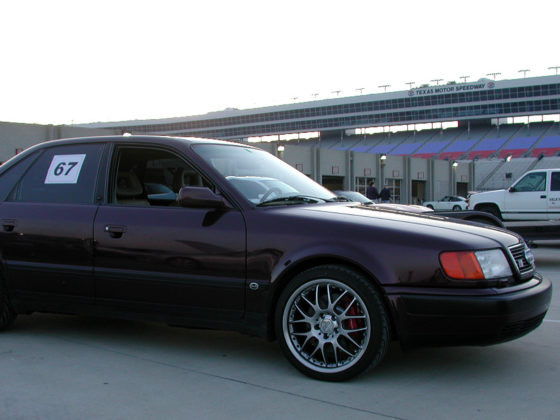
The next step in painting my eS2 track car was to disassemble and strip the body. We removed the sunroof, windows, hood, bumpers, hatch, door mirrors, and all of the body trim. The next thing we did was to use a product called Klean-Strip Aircraft Remover to remove the paint. This might have been the most noxious chemical to which I have ever been exposed. In fact, this stuff is so dangerous, the warning label basically reads please do not use this product. The upside to the additional brain damage we suffered for using Aircraft Remover is that it was quite effective. We brushed it onto the surface of the car’s body and within seconds the paint would bubble up. After a couple of minutes, we would scrape the paint off, usually with one pass of a paint scraper, leaving nothing but bare metal. It burned through clear coat, paint, primer, and would even take chunks out of body filler. Unfortunately, it also ate through anything else it touched, including our gloves and skin. Often we would be scaping and a small flake of paint would get flicked onto an arm or leg. A minute or so later, one of us would yelp and start hopping around as it would start to burn through to our skin.

Also, there was definitely an 80/20 rule that applied. 80% of the paint came off with 20% of our effort (one pass of the Aircraft Remover and a paint scraper), but there were stubborn areas and smaller detail areas that took multiple applications of the stripper and a lot of elbow grease. It took a couple of days to get all of the paint off of the car. When we were done, the right side looked pretty good, but the left side looked like this:

All of the body panels had lots of poorly applied body filler. The front left wing was so bad that Ken finally gave up trying to make it look good, which is one of the reasons we planned for the whole front of the car to be white – we knew that we would eventually have to replace that fender and it will be easier to shoot it in just one color. Having the car in that condition was the most discouraging point of the whole project. The car looked worse than ever and a lot more body damage had been revealed in the process.

The next step was to sand all of the trim pieces. What a bloody mess. Red paint dust everywhere. I thought my wife would kill us all. First it was toxic fumes in the house and then it was red fingerprints on everything. The whole process was miserable. Sanding is messy and boring. It’s also incredibly frustrating. I would sand and sand and sand. Then Ken would come look at what I had done and say it wasn’t smooth enough. I would sand and sand and sand again. Then Ken would come look and say that I had sanded through some layer that I wasn’t supposed to. So, I tried to find other things to do, like tape up the car or drink a beer.

Finally, we were able to get the car cleaned-up and prepped enough for Ken to lay down some primer. As soon as the primer was on, we had to…you guessed it…sand the whole car again. This went on until Ken finally had to go out of town.
A couple of months later, Ken returned (sans ponytail!) and we got back to work on the Coupe. He finally began to shoot paint!

There were some problem areas where he couldn’t get the paint to properly adhere to the surface, but in most cases, it was because we hadn’t prepped the area adequately. The biggest lesson out of this whole experience was of the importance (and hard work) of surface prep. One little shortcut can cost hours of work later. I now have a very real understanding of why a good paint job costs so much money.
As soon as a coat or two of Alpine White was on the car, Ken went back to Florida. I flew out and went to Sebring with him and his dad in March, but Ken wouldn’t be back in Austin for seven months.
Project Links
Gallery

Please pin, tweet, and share! Most importantly, let me know what you think in the comments below.













































